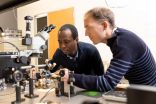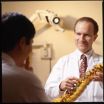(Press-News.org) Rats that received thyroid hormones had a reduced risk for dangerous heart arrhythmias following a heart attack, according to a new study by a team of medical researchers at New York Institute of Technology.
In the NIH-funded study, published in the Journal of Cardiac Failure, the team found that thyroid hormone replacement therapy significantly reduced the incidence of atrial fibrillation - a specific kind of irregular heartbeat, or arrhythmia -- in the rats, compared to a control group that did not receive the hormones.
The finding could have important implications for future treatment of human patients, says lead researcher Youhua Zhang, MD, Ph.D., noting that up to about half of the humans with heart failure also suffer from atrial fibrillation.
"Our data highlights the potential clinical importance of correcting thyroid dysfunction to prevent cardiac arrhythmias and atrial fibrillation in heart failure," Zhang and the researchers wrote in their study. "In other words, withholding thyroid hormone treatment in heart failure may do harm when cardiac hormone levels are below normal."
Zhang said researchers induced heart attacks in a group of 29 rats. Fourteen were treated with a form of thyroid hormone known as T4. After two months of treatment, the researchers measured cardiac function and then attempted to induce rapid and irregular heartbeats. Eleven of the 15 animals in the control group developed the arrhythmia but only four of the 14 animals treated with the thyroid hormone developed an arrhythmia.
"With T4 treatment of these animals with myocardial infarctions, they are more resistant to developing arrhythmias," Zhang said.
Zhang's study builds upon previous studies conducted at NYIT that demonstrate links between thyroid hormones and heart health in animal models. Five months ago, Zhang's collaborator A. Martin Gerdes, Ph.D., published a study in Molecular Medicine that found administering low doses of the active form of the thyroid hormone known as T3 prevented the development of heart disease in rats with diabetes. Previously, Gerdes has published studies demonstrating that hypertension and heart attacks also trigger low cardiac thyroid hormone levels and contribute to heart disease.
Gerdes and Zhang believe that human clinical trials involving patients with heart failure may lead to findings that radically change heart failure treatment protocols.
The current study notes reluctance to use thyroid hormone replacement therapy in humans with heart diseases likely has its roots in several studies that used excessive doses of thyroid hormones or thyroid mimics.
INFORMATION:
About NYIT
New York Institute of Technology (NYIT) offers 90 degree programs, including undergraduate, graduate, and professional degrees, in more than 50 fields of study, including architecture and design; arts and sciences; education; engineering and computing sciences; health professions; management; and osteopathic medicine. A non-profit independent, private institution of higher education, NYIT has more than 12,000 students attending campuses on Long Island and Manhattan, online, and at its global campuses. NYIT sponsors 11 NCAA Division II programs and one Division I team.
Led by President Edward Guiliano, NYIT is guided by its mission to provide career-oriented professional education, offer access to opportunity to all qualified students, and support applications-oriented research that benefits the larger world. To date, nearly 100,000 graduates have received degrees from NYIT. For more information, visit nyit.edu.
San Diego, Calif., Dec. 10, 2014 -- Engineers at the University of California, San Diego have demonstrated a new and more efficient way to trap light, using a phenomenon called bound states in the continuum (BIC) that was first proposed in the early days of quantum wave mechanics.
Boubacar Kanté, an assistant professor in electrical and computer engineering at UC San Diego Jacobs School of Engineering, and his postdoctoral researcher Thomas Lepetit described their BIC experiment online in the rapid communication section of journal Physical Review B. The study directly ...
Researchers from North Carolina State University and Qatar University have developed a new "high-entropy" metal alloy that has a higher strength-to-weight ratio than any other existing metal material.
High-entropy alloys are materials that consist of five or more metals in approximately equal amounts. These alloys are currently the focus of significant attention in materials science and engineering because they can have desirable properties.
The NC State research team combined lithium, magnesium, titanium, aluminum and scandium to make a nanocrystalline high-entropy ...
Is it the thought that really counts?
When it comes to giving gift cards, maybe not.
New research from the University of Cincinnati can help even the most thoughtful gift giver avoid the mistake of over-personalization and keep that card from being banished to the bottom of a purse or hidden deep inside a wallet for the next six months.
"Givers often fail to anticipate that the gifts they prefer to give are not necessarily the ones recipients prefer to receive," says Mary Steffel, researcher and assistant professor of marketing in UC's Carl H. Lindner College of Business.
So ...
CORVALLIS, Ore. - Researchers for the first time have developed a method to track through the human body the movement of polycyclic aromatic hydrocarbons, or PAHs, as extraordinarily tiny amounts of these potential carcinogens are biologically processed and eliminated.
PAHs, which are the product of the incomplete combustion of carbon, have been a part of everyday human life since cave dwellers first roasted meat on an open fire. More sophisticated forms of exposure now range from smoked cheese to automobile air pollution, cigarettes, a ham sandwich and public drinking ...
Many children who sustain so-called open bone fractures in the forearm or lower leg can, and do, heal safely without surgery, according to the results of a small study led by investigators at the Johns Hopkins Children's Center.
Open fractures occur when the broken bone protrudes through the skin, causing a puncture wound.
The study, published ahead of print in the Journal of Children's Orthopaedics, shows that when the wound is small -- less ½-inch in diameter -- and the surrounding tissue is free of visible contamination with dirt or debris, children heal well ...
CAMBRIDGE, MA, December 10, 2014 - A team of investigators from the Broad Institute, Massachusetts General Hospital and other leading biomedical research institutions has pinpointed rare mutations in a gene called APOA5 that increase a person's risk of having a heart attack early in life. These mutations disable the APOA5 gene and also raise the levels in the blood of triglyceride-rich lipoproteins, a type of fat. The researchers' findings, together with other recent genetic discoveries -- specifically, the identification of protective mutations in the APOC3 gene that lower ...
Stem cells in early embryos have unlimited potential; they can become any type of cell, and researchers hope to one day harness this rejuvenating power to heal disease and injury. To do so, they must, among other things, figure out how to reliably arrest stem cells in a Peter Pan-like state of indefinite youth and potential. It's clear the right environment can help accomplish this, acting as a sort of Neverland for stem cells. Only now are scientists beginning to understand how.
New collaborative research between scientists at Rockefeller University and Memorial ...
The dragonfly is a swift and efficient hunter. Once it spots its prey, it takes about half a second to swoop beneath an unsuspecting insect and snatch it from the air. Scientists at the Howard Hughes Medical Institute's Janelia Research Campus have used motion-capture techniques to track the details of that chase, and found that a dragonfly's movement is guided by internal models of its own body and the anticipated movement of its prey. Similar internal models are used to guide behavior in humans.
"This highlights the role that internal models play in letting these creatures ...
INDIANAPOLIS -- How do some proteins survive the extreme heat generated when they catalyze reactions that can happen as many as a million times per second? Work by researchers from Indiana University-Purdue University Indianapolis (IUPUI) and the University of California Berkeley published online on Dec. 10 in Nature provides an explosive answer to this important question.
Proteins are essential to the human body, doing the bulk of the work within cells. Proteins are large molecules responsible for the structure, function, and regulation of tissues and organs. Enzymes ...
CORVALLIS, Ore. - Nitrous oxide (N2O) is an important greenhouse gas that doesn't receive as much notoriety as carbon dioxide or methane, but a new study confirms that atmospheric levels of N2O rose significantly as the Earth came out of the last ice age and addresses the cause.
An international team of scientists analyzed air extracted from bubbles enclosed in ancient polar ice from Taylor Glacier in Antarctica, allowing for the reconstruction of the past atmospheric composition. The analysis documented a 30 percent increase in atmospheric nitrous oxide concentrations ...








